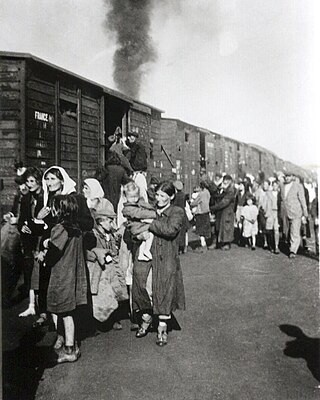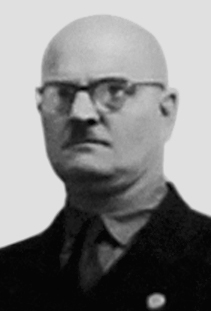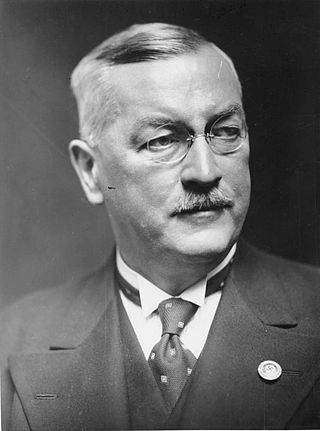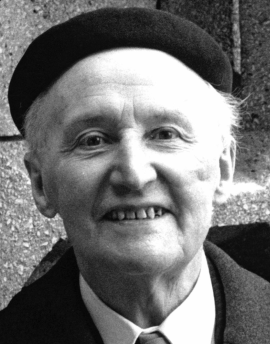
Aktion T4 was a campaign of mass murder by involuntary euthanasia in Nazi Germany. The term was first used in post-war trials against doctors who had been involved in the killings. The name T4 is an abbreviation of Tiergartenstraße 4, a street address of the Chancellery department set up in early 1940, in the Berlin borough of Tiergarten, which recruited and paid personnel associated with Aktion T4. Certain German physicians were authorised to select patients "deemed incurably sick, after most critical medical examination" and then administer to them a "mercy death". In October 1939, Adolf Hitler signed a "euthanasia note", backdated to 1 September 1939, which authorised his physician Karl Brandt and Reichsleiter Philipp Bouhler to begin the killing.

Operation Reinhard or Operation Reinhardt was the codename of the secret German plan in World War II to exterminate Polish Jews in the General Government district of German-occupied Poland. This deadliest phase of the Holocaust was marked by the introduction of extermination camps. The operation proceeded from March 1942 to November 1943; about 1.47 million or more Jews were murdered in just 100 days from late July to early November 1942, a rate which is approximately 83% higher than the commonly suggested figure for the kill rate in the Rwandan genocide. In the time frame of July to October 1942, the overall death toll, including all killings of Jews and not just Operation Reinhard, amounted to two million killed in those four months alone. It was the single fastest rate of genocidal killing in history.

Christian Wirth was a German SS officer and leading Holocaust perpetrator who was one of the primary architects of the program to exterminate the Jewish people of Poland, known as Operation Reinhard. His nicknames included Christian the Cruel, Stuka, and The Wild Christian due to the extremity of his behaviour among the SS and Trawniki guards and to the camp inmates and victims.
Gedenkdienst is a concept in Austria aimed at young people to face and take responsibility for the darkest chapters of the country's history while being financially supported by Austrian government.

The Austrian Service Abroad is a non-profit organization funded by the Austrian government which sends young Austrians to work in partner institutions worldwide serving Holocaust commemoration in form of the Gedenkdienst, supporting vulnerable social groups and sustainability initiatives in form of the Austrian Social Service and realizing projects of peace within the framework of the Austrian Peace Service. The Austrian Service Abroad is the issuer of the annually conferred Austrian Holocaust Memorial Award.

Franz Gürtner was a German Minister of Justice in the governments of Franz von Papen, Kurt von Schleicher and Adolf Hitler. Gürtner was responsible for coordinating jurisprudence in Nazi Germany and provided official sanction and legal grounds for a series of repressive actions under the Nazi regime from 1933 until his death in 1941.

Sonderaktion1005, also called Aktion1005 or Enterdungsaktion, was a top-secret Nazi operation conducted from June 1942 to late 1944. The goal of the project was to hide or destroy any evidence of the mass murder that had taken place under Operation Reinhard, the attempted extermination of all Jews in the General Government occupied zone of Poland. Groups of Sonderkommando prisoners, officially called Leichenkommandos, were forced to exhume mass graves and burn the bodies; inmates were often put in chains to prevent them from escaping.
The Buber-Rosenzweig-Medaille is an annual prize awarded since 1968 by the Deutscher Koordinierungsrat der Gesellschaften für Christlich-Jüdische Zusammenarbeit (DKR; German Coordinating Council of Societies for Christian-Jewish Cooperation) to individuals, initiatives, or institutions, which have actively contributed to Christian–Jewish understanding. Forty-four different societies belong to the DKR. The name of the prize honors the memory of the Austrian-Jewish philosopher, translator, and educator Martin Buber (1878–1965) and the German-Jewish theologian Franz Rosenzweig (1886–1929). In its inaugural year, the prize was granted to both the historian Friedrich Heer and the Protestant theologian Friedrich-Wilhelm Marquardt.

Operation Reinhard in Kraków, often referred to by its original codename in German as Aktion Krakau, was a major 1942 German Nazi operation against the Jews of Kraków, Poland. It was headed by SS and Police Leader Julian Scherner from the Waffen-SS. The roundup was part of the countrywide Aktion Reinhard, the mass murder of Polish Jews in the so-called General Government under the command of SS und Polizeiführer Odilo Globočnik.
Aktion Kinder des Holocaust is a Swiss voluntary association founded in 1991. Its principal aim is the documentation of and opposition to antisemitism in Switzerland. It is associated with the University of Basel research projects "VIOLENCE youth" and "Right-wing youths in Switzerland".

Lothar Kreyssig was a German judge during the Weimar and Nazi era. He was the only German judge who attempted to stop the mass-murder of persons deemed "unworthy of living" under the Aktion T4 "involuntary euthanasia" program, an intervention that cost him his job. After the Second World War, he was again offered a judgeship but declined. Later, he became an advocate of German reconciliation and founded the Action Reconciliation Service for Peace and the German development aid non-government organization, Action for World Solidarity.
Herbert Rosenkranz was a Jewish historian.

Thomas Lutz is the head of the Memorial Museums Department of the Topography of Terror Foundation in Berlin, and active in Holocaust education and research at the national (German) and international level.
The Russian Research and Educational Holocaust Center was founded in 1992 in Moscow and has since then been working on awareness raising of the Holocaust in the Russian society. It is the only non-governmental organization in the Russian Federation, devoted to the study of the life of Soviet Jews during the Great Patriotic War.
The International Youth Meeting Center in Oświęcim/Auschwitz is an educational institution whose campus lies between the center of the Polish city of Oświęcim and the former German concentration camp of Auschwitz. More than one million persons, mostly Jewish and Polish, were murdered at Auschwitz during the Second World War (1939–1945). Proposed in 1971, the center was opened in 1986 following years of planning, negotiations, and fundraising. It seeks to "develop the understanding of National Socialism and its consequences, particularly among young Germans, through dialogue and encounter between people of different origins", and is particularly engaged with Germans and Poles, Christians and Jews. In 2010, the Center hosted more than 17,000 overnight stays by youth groups participating in its programs. Many young Germans and Austrians have held year-long voluntary positions at the Center that satisfy their civilian service (Zivildienst) responsibility. One of these, Robert Thalheim, wrote and directed the German-language dramatic film And Along Come Tourists (2007) that features the center and its activities.

Kokelv Church is a parish church of the Church of Norway in Hammerfest Municipality in Finnmark county, Norway. It is located in the village of Kokelv. It is the church for the Kokelv parish which is part of the Hammerfest prosti (deanery) in the Diocese of Nord-Hålogaland. The white, wooden church was built in a long church style in 1960 using plans drawn up by the architect Rolf Harlew Jenssen. The church seats about 120 people.

During World War II, Trawniki men were Eastern European Nazi collaborators, consisting of either volunteers or recruits from prisoner-of-war camps set up by Nazi Germany for Soviet Red Army soldiers captured in the border regions during Operation Barbarossa launched in June 1941. Thousands of these volunteers served in the General Government territory of German-occupied Poland until the end of World War II. Trawnikis belonged to a category of Hiwis, Nazi auxiliary forces recruited from native subjects serving in various jobs such as concentration camp guards.

The Jewish Cemetery in Wschodnia street, Białystok was created in 1891, after the closure of the old cemetery, the Rabbinic Cemetery, on Kalinowskiego Street. The Jewish cemetery is a listed heritage monument.
The M-Aktion, was a Nazi looting organisation. Attached to the "Einsatzstab Reichsleiter Rosenberg", starting in early 1942 the M-Aktion looted approximately 70,000 homes of French, Belgian, and Dutch Jews who had either fled or had been deported.












